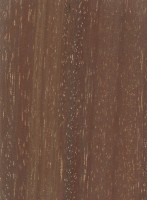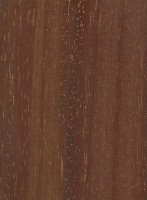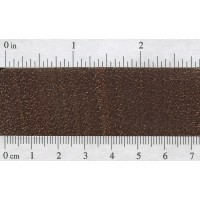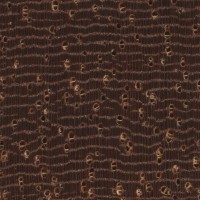 |
Common Name(s): Ekki, Azobe Scientific Name: Lophira alata Distribution: West Africa Tree Size: 100-150 ft (30-46 m) tall, 5-6 ft (1.5-1.8 m) trunk diameter Average Dried Weight: 66 lbs/ft3 (1,065 kg/m3) Specific Gravity (Basic, 12% MC): .82, 1.06 Janka Hardness: 3,220 lbf (14,330 N) Modulus of Rupture: 28,390 lbf/in2 (195.8 MPa) Elastic Modulus: 2,754,000 lbf/in2 (18.99 GPa) Crushing Strength: 13,890 lbf/in2 (95.8 MPa) Shrinkage: Radial: 8.0%, Tangential: 11.1%, Volumetric: 18.3%, T/R Ratio: 1.4 |
Color/Appearance: Heartwood is a dark reddish or violet brown. Pores contain light-colored mineral deposits which form small but conspicuous streaks throughout the wood. Sapwood is a pale pinkish white, with a gradual transition zone between the heartwood and sapwood.
Grain/Texture: Grain is interlocked, with a coarse texture and low natural luster.
Endgrain: Diffuse-porous; predominantly in radial multiples; very large pores in no specific arrangement, very few; light-colored mineral deposits common; parenchyma banded; narrow rays, spacing fairly close.
Rot Resistance: Rated as very durable, with good resistance to insect attacks. Good weathering characteristics.
Workability: Difficult to work on account of its density and interlocked grain, which can cause tearout. Ekki also has a pronounced blunting effect on cutting edges. Gluing can also pose problems due to its density and oil content.
Odor: No characteristic odor.
Allergies/Toxicity: Although severe reactions are quite uncommon, Ekki has been reported to cause skin irritation. See the articles Wood Allergies and Toxicity and Wood Dust Safety for more information.
Pricing/Availability: Ekki is seldom available in the United States, though it tends to be more readily available in Europe. Prices are expected to be in the mid to high range for an imported hardwood.
Sustainability: This wood species is not listed in the CITES Appendices, but is on the IUCN Red List. It is listed as vulnerable due to a population reduction of over 20% in the past three generations, caused by a decline in its natural range, and exploitation.
Common Uses: Bridges, boatbuilding, marine applications, decking, and flooring.
Comments: This tough, durable wood can be difficult to work, but its longevity (especially in marine applications) make it well worth the effort.
None available.
Scans/Pictures: A special thanks to Steve Earis for providing the wood sample of this wood species.








I have a steel bridge with ekki hardwood boards and rail. The wood has turn a grey colour and I would like to know is it worth rubbing down and oiling the wood to get back to the redish colour it had?
If so what oil do you suggest I use?
This wood gives off a very bad smell when it is machined because of the heat. This smell decreases greatly when the wood cools down and disappears when the wood is varnished.
The tree (ekki) can easily be found in River Gee, Grand Gedeh, Sinoe and Nimba Counties in Liberia, West Africa. Everywhere in River Gee (Kiteabo & Glarro) the tree can be found.
Back in the late 70’s I worked in Nigeria for African Timber and Plywood Ltd., Sapele in Bendel State as it was then. The original Sawmill building which was mainly built with local timber around 1950 had a stilt foundation of Ekki wood which was removed in 1980 to accommodate a new mill and was as good as the day it was installed. It was 300 x 300 x 12000mm. The timber was reused as bearers in the log steam pits for the Plymill and may very well be still there till now. This wood is best milled when fresh… Read more »
Ekki wood also apparently has a resistance to certain chemicals. Pieces of it were used at a chemical plant (where I was formerly employed) instead of metals . The pieces of wood used were about the dimensions of 2×6 construction lumber, and about 3 feet long. I’m not sure what they were used for at the plant, but it may have been used in the manufacture or storage of fuming sulfuric acid ( oleum). This plant could have used any material they wished, but they chose Ekki wood. I recently tried to cut some of the pieces I purchased from… Read more »
did it smell like nasty cheese / vomit by any chance ?
Yes! So this is what I have exactly then. I wasn’t sure because it looks like ekki but according to the Wood Database, there’s no odor. But is there ever! Stinks like feet and vomit! Since it was reclaimed wood that I was using, I assumed it was due to that. So I cleaned it with dish soap as you do for reclaimed wood. No change. And man is this stuff hard to cut…blunts everything.
Yes, those are two odors that would fit. The odor actually frightened me, and I never again sawed any of the pieces I purchased from the chemical plant. The odor, of course, may have come from absorbed chemicals still in the wood.
jw- It may have smelled like those, but I don’t remember . Sorry .
A turned bowl from Ekki wood
Looks good, nice to see what the sapwood looks like too.
I have made many bowls from it in lathe , turns well, sands also well and very dense and heavy wood, i got one large piece form railway company, used as railroad pipeline
Very hard wood to work with . I was given loads of 9 X 2 that was used as quay heading in the rivers for many decades , completely rot proof and not nice to work with . I found any splinter will go septic within hours and should be removed immediately . I glued some sections together , this completely failed as the wood warped , the glue , evosticl external was useless . As wood for joinery , it’s differ cult to polish or make something of beauty . It’s ideally suited anywhere that needs super strength and… Read more »
I feel like the wood you got was damaged due to its previous use, i have used ekki to make various items and got the complete opposite experience. sanded it up to 3000g and it had a lovely natural luster, it glued as well as you would expect for an oily wood (gorilla glue PU, still stuck no issues). Ekki is known to be difficult to dry so if it has been submerged for many decades before you got it, it would potentially need another decade to fully dry.
This wood makes me itch when working it. Use clothing protection, dust mask (as always) and shower and clean up after each use. But it’s a super dense wood with great outdoor characteristics, a pretty purple/brown color, and VERY HARD.
Another name for this is Bongossi.
I’ve also seen this going by the name Acupuri
After reevaluating, I do not think Acupuri and Ekki are the same wood. Pretty sure they are not.
We came across this wood through a customer and my husband made these beautiful grips for him. The wood was surprisingly easy to work for a hard wood. I heard nightmare stories of splintering and so forth but he did not get this. The pores in the wood are iridescent because of the mineral deposits. We did 2 coats of cyanoacrylate as a sealer and about 15 coats of tru-oil with a carnauba wax top coat.